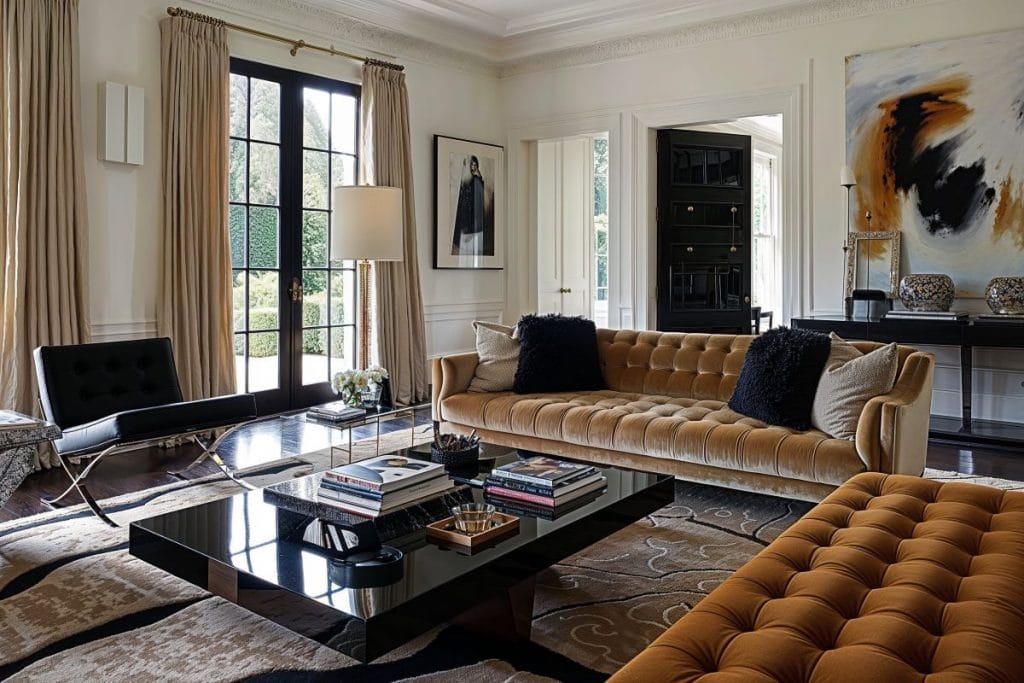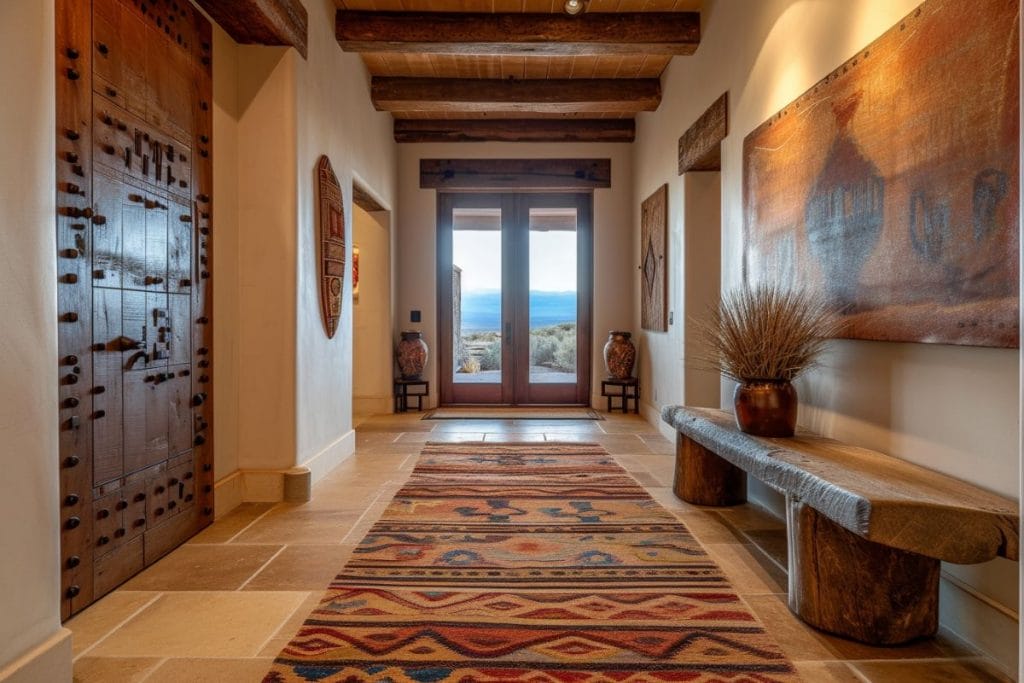
You know that feeling when a room evokes an instant sense of wholesomeness, like every element seems to be in perfect harmony? Achieving this level of interior finesse requires more than just an eye for beauty. It stems from a deep understanding of the fundamental interior design rules. Let’s have a look at ten guidelines and how to incorporate them into a successful decorating project.
1. Follow the Principle of Balance

Balance is the common feature of most interior design ideas, keeping one part of a room from overshadowing others. It’s about using color, texture, and furniture placement to create a grounded and welcoming space. To achieve this, spread out the visual weight evenly across the room. Try playing with different layouts, like symmetrical, asymmetrical, or radial, to see which one yields the most visually pleasing result.
Pro Tip: Utilize the interior design rules of thirds in your layout to create dynamic, interesting arrangements. Divide space into thirds, both vertically and horizontally, and disperse critical pieces within these zones.
Interior design rules apply to any design style. Not sure what yours is? Try our Free Interior Design Style Quiz to discover your ideal style!
2. Define a Focal Point

One of the most relevant interior design rules is that every room needs a clear emphasis. A focal point gives the room a sense of purpose, guiding attention to a key area. It can be anything from a design element, a piece of furniture, to artwork. Identify a centerpiece that will perfectly anchor your room, bringing everything together around a main theme or feature.
Pro Tip: As part of interior design principles, your focal point doesn’t have to be a single item. Consider creating a captivating setup around a fireplace, for example. Also, use strategic lighting to further accentuate this arrangement, ensuring it catches the eye immediately.
3. Pay Attention to Scale and Proportion

Oversized furniture can overwhelm a small room, while too-small pieces can look lost in a spacious layout. As a result, even the trendiest room will either feel cramped or evoke a sense of emptiness. To achieve a well-balanced setup, carefully consider the scale of your furnishings relative to your room’s dimensions. It will help you convey a harmonious living environment in return.
Pro Tip: Before purchasing furniture or decor, use painter’s tape to outline its dimensions on the floor or wall. This visual aid will help ensure the piece’s scale is appropriate for the space.
4. Implement Color Theory

Color theory belongs to the interior decorating rules that influence mood and spatial perception. Ignoring it can lead to disjointed and uncomfortable layouts, as hues that don’t complement each other produce visual chaos. To avoid the risk, focus on understanding the relationships between shades, such as complementary or analogous. By carefully selecting a color scheme that aligns with the desired atmosphere and function of your space, you’ll enhance both its beauty and livability.
Pro Tip: Use a color wheel to find complementary colors for accents. For instance, if your room is mainly cool tones, add a few warm accents to balance the energy.
5. Layer Lighting

Proper illumination is vital not only for functionality but also for adding depth and interest to a room. A lack of it can leave spaces feeling one-dimensional or unwelcoming. To create a dynamic yet serviceable atmosphere, start with ambient lighting for overall illumination. Next, add task lighting for specific activities and finish with accent lighting to highlight features or objects.
Pro Tip: Incorporate dimmer switches for ambient lighting to adjust the room’s atmosphere easily. It will allow for greater flexibility and control over the ambiance to suit any occasion or time.
6. Consider Texture and Pattern

Texture and pattern can do wonders for space dynamics. This is one of the vital interior design guidelines for monochromatic schemes where, without these elements, the rooms can feel flat and lifeless. Employ thoughtful combinations to create visual interest and a sense of movement within the space. That way, you will invite the eye to dance from one point to another, establishing a cohesive flow that enhances the overall sense of rhythm.
Pro Tip: Start with a dominant pattern or texture as your base, then layer in additional elements that complement without overwhelming.
7. Master Contrast for Visual Interest

Contrast is essential in creating a visually engaging room. Similarly to the absence of textures and patterns, the room without contrasting elements can appear monotonous and uninspiring. Juxtapose color, texture, or form to define spaces, highlight features, and bring more depth. In addition, balance disparity by pairing bold elements with more subdued ones.
Pro Tip: Use contrasting elements in moderation to avoid overwhelming the space. For example, combine a vibrant color with neutral tones, or mix rough textures with smooth finishes for a cohesive yet striking effect.
8. Put Negative Space to Work

Negative space is one of the interior design rules often overlooked in non-professional home decorating. Yet, it plays a crucial role in defining the look and feel of a room. If you neglect the negative space, there’s a big chance you’ll overstuff the layout. Allow some areas of your design to remain unoccupied: think of them as highlights and frames of the pieces you choose to include.
Pro Tip: Strategically use negative space to create focal points and improve the room’s flow, enhancing both its aesthetic and functional appeal.
9. Establish Harmony Between All Interior Design Rules

Although diverse, home decorating rules should still work together to convey harmony, where elements complement each other. Otherwise, a room can feel disjointed and unsettling, as if every piece competes for attention. The best way to avoid that is to carefully select colors, materials, and furniture sharing a common style or aesthetic. Planning in advance with a thoughtful approach will ensure the space feels well-balanced and restful.
Pro Tip: Utilize a consistent color palette across different elements and textures. It will tie the room together but also enhance its overall equilibrium.
10. Functionality is Fundamental

A cornerstone in the rules for interior decorating ensures that a space is as practical as it is aesthetically pleasing. Ignoring functionality can lead to a beautiful yet unserviceable room, undermining its overall comfort and usability. Focus on sourcing furniture and decor that support inhabitants’ daily activities. Moreover, consider the flow of movement and aim to facilitate easy navigation.
Pro Tip: Incorporate storage solutions that are decorative and practical at the same time, to maintain a clutter-free environment.
Leave the Implementation of Home Decor Rules to a Professional
With years of experience, our designers know how to make interior design rules work best for you. Book your Free Online Interior Design Consultation to start your project today!










Comments